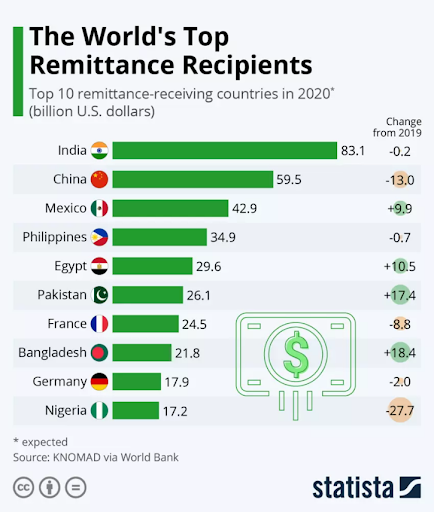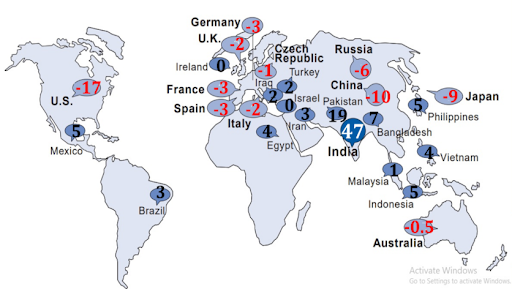
Introduction
There are more than 32 million Overseas Indians, including the Indian diaspora (Persons of Indian Origin or PIOs) in 210 countries working tirelessly for the growth of the country of stay while at the same time they retain a deep connection with India and also contribute to their own well-being.
They constitute a whopping 1T $ Economy and in this Covid era have played a great role in bringing comfort to the world which has seen many epidemics, but all the previous ones were largely contained within the regions where they originated. However, COVID-19 has affected nearly every country in the world in the last two years and left behind a trail of economic misery.
India’s relations with its PIOs abroad has, in recent years become better and highly interactive with a number of government outreach programmes initiated including the Pravasi Bharitiya Divas. Many PIOs interact daily with their relatives and friends in India and for professional purposes as well. With newer and innovative Technology, the interactions with India and Indians are growing rapidly. India has acknowledged and welcomed the contribution that the Overseas Indians have made to its development by way of remittances, investments and deposits which is estimated to be more than 80 B $. ‘They have brought a good amount of technology along with propriety rights into India. India has introduced several measures to meet the aspirations of the PIOs including taking measures for protection of their interests in India and abroad. India has been proactive in interceding with the host countries when problems arise for the PIOs, even though they had gone on their own. In countries where the Indians are powerful and influential, they became India’s unofficial ambassadors, who promote Indian interests there. On balance, both sides have benefited from this cooperation.
Globalized cities are the most vulnerable and, by extension, any country that transacts through them is at risk. The only way to prevent future pandemics is to build stronger and more effective public health systems across countries. That means more global cooperation, not less and in this there is a very big role for India and Indians abroad as these 32 million Indians/PIOs are the most spread people globally. As the world has globalised rapidly, many emerging challenges have thrown systems out of gear across the world including in India. One of the most devastating issues that the world is currently grappling with is the Covid-19 induced disruption.
The advent of the unprecedented pandemic, COVID- 19 has posed several challenges for India in protecting its population, including addressing the expectations from its diaspora in this hour of crisis. The roles of India as the recipient and the diaspora as the giver are likely to be reversed even if some of the 32.14 million diasporas spread across the world turn to India for support. Added to this is the real danger of loss of lives among the diaspora resulting in cases of deprivation and misery and sometimes being left without recourse to assistance from the host country. Unless the spread of coronavirus is halted and the world economy recovers, India may have to step in and take responsibility to facilitate and help those diasporas who have been affected adversely by the pandemic. India did help with evacuations of stranded and suddenly unemployed Indian diaspora in some countries. The Indian government’s timely intervention and assistance has been acknowledged by the diaspora spread out in different regions and across various segments. Indians in the medical profession abroad are among the best medical professionals taking care of the affected people in respective host countries and in some cases have lost their lives to the viral Covid-19.

If the pandemic continues unabated, there is also the issue of skill shortage if the number of fatalities continue to rise. Looking at history, it is seen that the Black Death pandemic killed more than 20 million people between 1347 and 1352 in Europe alone and this was one-third or more of the entire continent’s population. As a result, soon after, there was a huge shortage of skilled labour in every sector which created wage fluctuations on the one hand and unemployment (thanks to wrecked economies) on the other hand. As Covid-19 goes to its conclusive stage there would be huge requirements for skilled personnel and here is an opportunity for Indians throughout the world, to meet this skill shortage which is likely to arise in the aftermath of the pandemic and India needs to prepare for this given its large young tech savvy population.
Historians have pointed out that the Plague had an interesting impact on the feudal lords, who held most of the land in Europe then and the farmers who worked on their land. Since it became more and more difficult to get people to work on farmlands and do other chores, farmers started demanding better pay and this led to a deep socio-political crisis in Europe. The impact of Covid-19 on the labour markets will be broader based and hence would require concerted measures at the global level to bring markets and the economies back to normal. An important scenario is that, considering the way Covid-19 has exposed the chinks in the market- the crisis offers the working-class Indians an opportunity to get work and start with better wages, social security and an equitable share in labour-enabled profits.
Diaspora remittances have long played an important role in the developmental needs of home countries. In 2021, the top five remittance recipients in current US dollar terms were India, China, Mexico, the Philippines, and the Arab Republic of Egypt. As a share of gross domestic product, the top five remittance recipients in 2021 were smaller economies: Tonga, Lebanon, the Kyrgyz Republic, Tajikistan, and Honduras. The United States was the most significant source country for remittances in 2020, followed by the United Arab Emirates, Saudi Arabia, and Switzerland. Remittances are expected to continue growing in 2022, but there are downside risks. The COVID-19 crisis is far from over and poses the most crucial downside risk to the outlook for global growth, employment, and remittance flows to Lower- and Middle-Income countries (LMICs). The fiscal stimulus programs in major migrant destination countries cannot continue indefinitely. Moreover, the shift from cash to digital remittance channels, which was observed at the peak of the COVID-19 crisis in 2020, has likely run its course. Further growth will require accelerating access to bank (transaction) accounts for migrant populations. In India, remittances are projected to fall by about 23% in 2020, to US$64 billion – a striking contrast with the growth of 5.5% and receipts of US$83 billion seen in 2019,” the World Bank said in a report on impact of COVID-19 on migration and remittances. The most widely recognised immediate benefit from the international labour migration remains the flow of remittances, which not only augments scarce foreign exchange but also provides a potential source of additional savings and capital formation.
The Covid-19 outbreak, and the resulting slowdown has cost many people their salaries, jobs and much more. Indian billionaires are not immune to its effects either. Collectively all of India’s 102 billionaires lost US$93 billion or a quarter of their wealth. Indian billionaires are now worth US$313 billion as opposed to US$406 billion last year – that is 23% lower than what they held at last year.

Potential Surplus / Deficit Population in Working Age Group – 2020 (million)

While India struggles with a burgeoning population of educated youth, the rest of the world, especially developed countries, faces a shortage of working-age people, caused largely by lower birth rates and an ageing working population. While the requirement for skilled workers in these markets is increasing in line with economic growth, the availability of skilled people simply isn’t keeping pace. In professions like IT services, medicine, and education, the problems are already beginning to be felt. In addition to developed countries, even some emerging/developing countries such as China and Russia are likely to have a workforce shortage.
The challenges of workforce shortage faced by other nations present an opportunity for India. With its large population of educated youth, India can provide a host of services to such countries.
These services fall into two broad categories:
- Professional services to the world provided remotely from India – IT services, IT enabled services, telemedicine, e-learning, etc.
- Customers services in India (import of customers) – special service tourism (health care, education services), leisure tourism, etc.
Secured Governance for Education – A Channel for Prosperity through Knowledge Growth
Secured Governance for skill development is a strategy that relates to set up a relationship between development of Education infrastructures and various other sectors along with various institutions as partners and Government as the main governing body to foster, coordinate and create a defined “Skill Training Centre” along with various existing educational infrastructures or to create a new cluster/s in strategically defined locations that improves and develops the Centre as a whole through regional strategies, technology and interdependency among various other sectors of growth.
Despite a fairly large educated young workforce , the skill gap in India is clear – of the total workforce, proportion of formally skilled workforce in India is 4.69% compared to 24% in China, 52% in USA, 68%in UK, 75% in Germany, 80% in Japan and 96% in S. Korea. India Skill Report (2019) further identifies various levels of skill gaps. In fact the National Skill Development Policy (NSDP) since 2009 has been addressing the Skills mismatch in the economy! Under this policy the Government having recognised that skill development will play a vital role in transforming India into an ‘economic power to reckon with ‘had set a target of skilling 500 million people. For this the country has rightly understood the need to set up many Skills Universities including Private Skills Universities in partnership with the industry.
There is a strong correlation between skill levels and building skill capital. The National Skills Qualification Framework (NSQF) has defined levels of skills based on outcomes such as
- Depth of knowledge.
- Core Competencies.
- Professional skills and
- Responsibilities and Accountability
Thus, the levels vary from “skills involving simple and routine physical or manual task“(Level 1) to “skills involving operation of machinery and electronic equipment“ (Level 2) to “skills involving records of work“ (Level 3) to “decision making and creativity based contribution“ (Level 4 – High end Skills).
NSQF further classified skills into Domains Specific Skills and Soft Skills and concluded that Skills Universities conceptualised with a clear mandate of skill education can alone offer the necessary practical real-world training in industrial and services sectors to lay the foundation for the required skills training system in India. In the wake of Skill India Mission some Skills Universities have come up to provide standards in Skills field. These Universities exercise constant ingenuity and are providing innovative models.
The concept of secured governance does not believe that dramatic changes can be achieved only through a revolution that requires upturning all the procedures evolved through years of efforts and experience. It realizes the tools for bringing about effective and sustainable changes are already available in the system. They can be made more effective by defining linkages, effective response mechanism and dynamic feedback systems. Emphasis is placed on defining relationship between sectors of growth, institutions, and government to foster coordination and create an environment that improves the system through regional strategies, technology and by taking cognizance of the myriad interdependencies.
Secured governance for Education has major characteristics like participation, rule of law, transparency, and responsiveness, at each stage of its operations and in developing a robust education system in the country. With improved resource allocation, enhanced governance, Interdependency among sectors and transparency in the system going hand in hand with development and effective use of Information Technology and Innovation can deliver a safer, cleaner, and more accountable delivery of self-sustaining Education infrastructure and services, including utilising the PPP mode.
Diaspora and International Business in the Homeland
Migrations and international business have always been part of human history for many centuries. In fact, many diaspora members—immigrants who left their home countries to settle in developed countries—are concerned about the economic growth of their developing home countries and have been involved in various initiatives to promote international business and economic development in their home countries.
The impact of such involvement in the homeland economic development has been recognized by many experts, international institutions of development and governments of developing countries that have considered it as an important tool of economic development.
Investors rushed to dump equities typically considered risky assets as COVID 19 spread across geographies, while the more than 40-day nationwide lockdown in India added to the concerns of economic disruption. The panic sell-off by Foreign Institutional Investors (FIIs) led to massive liquidity outflow from domestic markets, dragging benchmark indices down by more than 25% in March 2021. FIIs sold Indian shares worth US$7.54 billion, while another US$7.36 billion was sold in debt instruments in March. In 2020 so far, FIIs are net sellers of US$14.69 billion, the highest annual outflow, both in equity and debt.
Yet, even these limited avenues seem attractive to NRIs at times, given the low rates of interest prevalent in their countries of residence, and given the fact that India is now being looked upon as a possible success story with immense potential.
More Potential to reap more Remittance through Secured Governance
India’s population is huge at 1.38 billion. It is fast expanding at a rate of 17% and integrating rapidly into the global economy. India is among the ‘young’ countries in the world, with the proportion of the work force in the age group of 15-59 years, increasing steadily. However, presently only 2% of the total potential workforce in India has undergone skills training. India has a great opportunity to meet the future demands of the world, India can become the worldwide sourcing hub for skilled workforce. Besides over 65% of India’s population is below 35 years of age; a robust skills training and certification system for these large numbers is a mammoth task. The youth dividend could easily turn into a youth liability. In addition, India has the largest population of English speakers. Due to its colonial legacy, English became a part of the Indian education system, which has now become an advantage. Indians thus have an edge over nationals of other countries due to their fluency in English.
Equipping the workforce with the skills required for the jobs of today and those of tomorrow is a strategic concern in the national growth and development outlook of India.
Some important points are:
- Each year around 3 million number of outflow work force will be increased through national skill development.
- The expected additional remittance would be US$10 billion at the CAGR 12.8%;
- Gaining knowledge and using it effectively is essential to ensuring continuous improvement in standard of skill development institutes;
- Enhancing individuals‟ employability and ability to adapt to changing technologies and global labour market demands.
- Improving productivity and living standards of the people.
- Developing a high-quality skilled workforce/entrepreneur relevant to current and emerging global employment market needs;
- Indian overseas people can set up a financial service in those countries having more Indian population. The financial institution can support fund transaction services for affordable percentage of remittance for Indian diaspora and other countries’ nationals as well. Moreover, these institutions can offer easy credit access to boost economic growth of host countries.
- Configure Indian law enforcement services with host country and ensure that the force could help them to maintain law and order in case of any Indian person commit crime in their territories. If a person from India committed offence in other countries, he will be penalised as per the host country’s law and punishment will be held in home country. There is no way to escape from the punishment.
- Overseas population need to be encouraged in ““Technology transfer cum Investment” in India, including attracting investment in skill development.
- India could look at preparing the workforce for global opportunities so that it can utilise its premium position as the human resource reservoir. Given the dynamic labour markets it also important the workforce re-learns, adapts, and readies itself as quickly as possible.
According to the World Bank, globally remittances are projected to decline sharply by about 20% this year due to the economic crisis induced by the COVID-19 pandemic and shutdown. In India, remittances are projected to fall by about 23% in 2020, to US$64 billion – a striking contrast with the growth of 5.5% and receipts of US$83 billion seen in 2019.”
Most of the Indian labourers and workers abroad are highly skilled and professional enough to get good jobs. By 2025, India’s demographic dividend is expected to contribute 25% of global workforce. They can be made more effective by defining linkages, effective response mechanism and dynamic feedback systems. Emphasis is placed on defining relationship between sectors of growth, institutions, and government to foster coordination and create an environment that improves the system through regional strategies, technology and by taking cognizance of the myriad interdependencies.
India is the only country expected to have a surplus of highly skilled financial and business services labour by 2030. India is projected to have a skilled-labour surplus of around 245.3 million workers by 2030, the only country expected to have a surplus, owing mainly to its vast supply of working-age citizens and government programmes to boost workers’ skills.
With the active association of Overseas Indians/PIOs, India could take on a greater share of the world’s Labor-intensive manufacturing jobs because of its quality and commitments. India could contribute and have greater global opportunity in technology and other knowledge-intensive fields. A designated region could be earmarked with the intent to attract foreign investment, retain local students, build a regional reputation by providing access to high-quality education and training for both international and domestic students, and create a knowledge-based economy. An education HUB can include different combinations of domestic/international institutions, branch campuses, and foreign partnerships, within the designated region.
Businesses worldwide need management graduates who have the tools to succeed globally – leadership skills, cultural awareness, foreign language proficiency, and an understanding of how the global marketplace functions. Outbound Exchange Programs could be implemented wherein India sends students to associated universities or corporate houses for skill development and knowledge exchange. Similarly, inbound Exchange Programs will facilitate initiatives for welcoming students from other countries to enable knowledge transfer targeting at least 10% of the students from other universities.
India is a rapidly rising economic power and will till 2030 have the youngest population in the world with 64% of its population in the working age group and India could capture a greater share of the world’s labor-intensive manufacturing jobs. Through secured governance it is necessary to establish a vibrant institutional framework in the educational system as India aspires to be a knowledge economy.
India could capitalise on the global opportunities in technology and other knowledge-intensive fields, including through encouraging and facilitating a robust innovation and start-up ecosystem.
Conclusion
India Startup360 pays Tribute to the Noble Soul Dr. P Sekhar, who authored this article before entering the Hospital. Post COVID devastation the Global Economy can recover. But it will take much longer time for the Startup Community to recover from this Devastation.
We will miss you Dr. Sekhar for Ever.
Sharing is caring!




